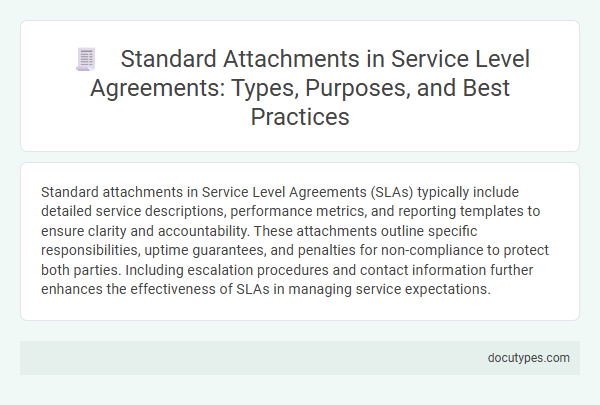Standard attachments in Service Level Agreements (SLAs) typically include detailed service descriptions, performance metrics, and reporting templates to ensure clarity and accountability. These attachments outline specific responsibilities, uptime guarantees, and penalties for non-compliance to protect both parties. Including escalation procedures and contact information further enhances the effectiveness of SLAs in managing service expectations.
Introduction to Standard Attachments in Service Level Agreements
Service Level Agreements (SLAs) often include standard attachments that define specific terms and conditions. These attachments enhance clarity and ensure both parties understand their responsibilities and expectations.
Standard attachments in SLAs typically cover performance metrics, reporting requirements, and escalation procedures. They provide detailed descriptions of service deliverables and penalties for non-compliance. Including these attachments helps maintain transparency and fosters a strong vendor-client relationship.
Common Types of Attachments in SLAs
What are the common types of attachments included in Service Level Agreements (SLAs)? Attachments in SLAs typically detail specific metrics, responsibilities, and processes to ensure clear understanding between service providers and clients. Standard attachments often include performance metrics, escalation procedures, and maintenance schedules.
Purpose and Importance of SLA Attachments
Attachments in Service Level Agreements (SLAs) define specific terms and detailed provisions that support the main contract. They ensure clarity and precision in service expectations and obligations.
- Scope of Services - Outlines detailed descriptions of the services provided to prevent misunderstandings.
- Performance Metrics - Specifies measurable standards for service quality and response times to ensure accountability.
- Penalty Clauses - Defines consequences and remedies for failure to meet agreed service levels, protecting your interests.
Performance Metrics and Reporting Schedules
| Attachment Type | Details |
|---|---|
| Performance Metrics | Defines key indicators such as uptime, response time, and resolution time. Metrics serve to measure the quality and efficiency of the provided service. Clear definitions ensure transparency and accountability between parties. |
| Reporting Schedules | Specifies the frequency and format of performance reports. Common schedules include weekly, monthly, or quarterly updates. These reports allow You to track service delivery against agreed metrics systematically. |
Roles and Responsibilities Matrices
Service Level Agreements (SLAs) commonly include attachments such as Roles and Responsibilities Matrices to clearly define the duties of all parties involved. These matrices detail specific tasks, accountability, and communication channels, ensuring transparent expectations between service providers and clients. Including a Roles and Responsibilities Matrix in Your SLA helps prevent misunderstandings and facilitates smooth collaboration throughout the contract period.
Escalation Procedures and Contact Lists
Service Level Agreements (SLAs) typically include several standard attachments that ensure clarity and accountability between parties. Two critical attachments are Escalation Procedures and Contact Lists, which outline the processes and communication channels during service disruptions.
- Escalation Procedures - Define the step-by-step process for addressing service issues that remain unresolved within specified timeframes.
- Contact Lists - Provide detailed information of responsible personnel, including names, roles, phone numbers, and email addresses for efficient communication.
- Service Resolution Timeline - Specifies time limits for issue resolution at each escalation level to maintain service quality standards.
Including these attachments in your SLA enhances responsiveness and ensures structured communication during critical service incidents.
Service Scope and Technical Specifications
Attachments in Service Level Agreements (SLAs) define crucial parameters ensuring clarity on the services provided. Service Scope and Technical Specifications are standard attachments that outline the extent of services and detailed technical requirements.
- Service Scope - This attachment specifies the range of services covered, detailing what is included and excluded to set clear expectations.
- Technical Specifications - It defines the technical requirements and standards, ensuring that the services meet necessary performance and quality criteria.
- Responsibility Matrix - Outlines the roles and responsibilities of both parties to ensure accountability and smooth operation within the agreed service parameters.
Compliance, Regulatory, and Legal Attachments
Standard Service Level Agreements (SLAs) typically include attachments focused on compliance, regulatory requirements, and legal obligations. These attachments ensure that service providers adhere to industry regulations and legal standards, protecting both parties involved. You should review these documents carefully to understand the specific compliance frameworks and legal responsibilities outlined in your agreement.
Best Practices for Drafting and Managing SLA Attachments
Standard attachments in Service Level Agreements (SLAs) typically include detailed service descriptions, performance metrics, and escalation procedures. These attachments provide clear expectations and measurable criteria to ensure service quality and accountability.
Best practices for drafting SLA attachments emphasize clarity, specificity, and alignment with business objectives. Regular reviews and updates help maintain relevance and adapt to changing service requirements or operational conditions.
What Attachments Are Standard in Service Level Agreements? Infographic

